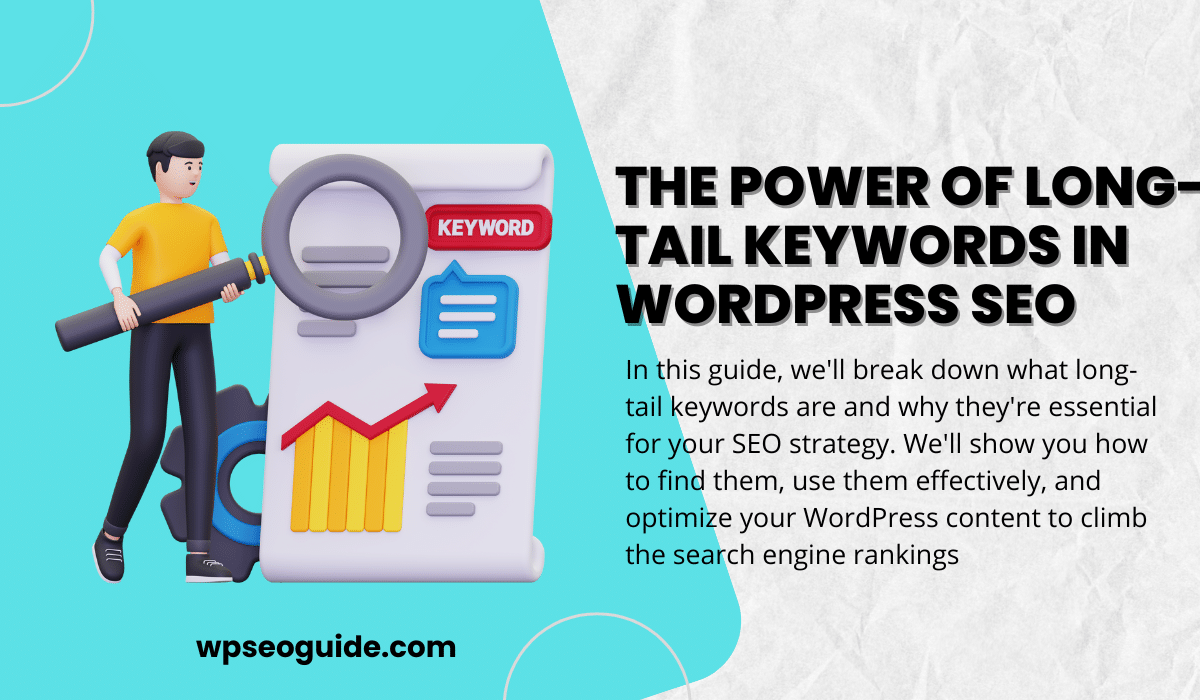Introduction
Navigating the world of SEO can sometimes feel like trying to crack a complex code. If you’ve been focusing solely on broad, popular keywords, you might be missing out on a secret weapon: long-tail keywords. These longer, more specific phrases can be a game-changer for your WordPress site’s SEO, helping you attract the right visitors and boost your engagement.
In this guide, we’ll break down what long-tail keywords are and why they’re essential for your SEO strategy. We’ll show you how to find them, use them effectively, and optimize your WordPress content to climb the search engine rankings. Whether you’re a seasoned blogger or just getting started, understanding “Long-Tail Keywords in WordPress SEO” can give your site the competitive edge it needs. Let’s dive in and discover how these powerful keywords can transform your WordPress SEO!
1. What are Long-Tail Keywords?
If you’ve ever searched for something very specific online, chances are you used a long-tail keyword. These are phrases that are usually three or more words long and are very specific to what someone is looking for. Unlike broad keywords like “shoes,” a long-tail keyword might be something like “best running shoes for flat feet.”
Examples of Long-Tail Keywords vs. Short-Tail Keywords
- Short-Tail Keyword: shoes
- Long-Tail Keyword: best running shoes for flat feet
- Short-Tail Keyword: digital marketing
- Long-Tail Keyword: effective digital marketing strategies for small businesses
- Short-Tail Keyword: recipes
- Long-Tail Keyword: easy vegan dinner recipes for beginners
Why does this matter? Well, long-tail keywords are less competitive, which means it’s easier for your content to rank higher in search results. Plus, the people using these detailed phrases are usually closer to making a decision or taking action. They know what they want and are looking for specific answers.
Think of it this way: if someone searches for “recipes,” they could be looking for anything from breakfast ideas to gourmet desserts. But if they search for “easy vegan dinner recipes for beginners,” you know exactly what they want. If your content matches that, they’re more likely to click on your site and engage with it.
Using long-tail keywords helps you attract a more targeted audience, which can lead to better engagement and higher conversion rates. It’s all about connecting with people who are looking for exactly what you offer. So, by focusing on these specific phrases, you’re not just attracting visitors—you’re attracting the right visitors.
2. Why Long-Tail Keywords Matter in SEO
You might be wondering, why should I bother with long-tail keywords? The answer is simple: they can make a big difference in your SEO strategy. Here’s why:
Lower Competition and Easier Ranking
Think of the internet as a massive marketplace. Short-tail keywords are like popular items that everyone wants, making them highly competitive. Long-tail keywords, on the other hand, are like niche products. Fewer people are competing for them, so it’s easier for your content to stand out and rank higher in search results.
Higher Conversion Rates
When someone types a specific phrase into a search engine, they usually know what they want. For example, a person searching for “affordable eco-friendly yoga mats” is likely ready to buy. This means that long-tail keywords often attract visitors who are closer to making a purchase or taking action, leading to higher conversion rates.
Enhanced Relevance and Specificity
Long-tail keywords help you connect with your audience on a more personal level. By targeting specific phrases, you can create content that directly addresses the needs and questions of your visitors. This makes your site more relevant and valuable to them, which can boost engagement and loyalty.
Imagine you’re running a travel blog. Instead of trying to rank for a broad term like “travel tips,” you could focus on “travel tips for solo female travelers in Europe.” This not only makes it easier to rank but also ensures you’re reaching people who are genuinely interested in your specific expertise.
In short, long-tail keywords are a powerful tool in your SEO arsenal. They help you attract a more targeted audience, improve your chances of ranking higher, and increase your conversion rates. By focusing on these specific phrases, you’re not just driving traffic—you’re driving the right traffic.
3. How to Find Long-Tail Keywords
Now that you understand the power of long-tail keywords, the next step is figuring out how to find them. Luckily, there are several tools and techniques that can help you uncover these valuable phrases. Here’s how:
Using Keyword Research Tools
There are plenty of tools out there designed to help you find long-tail keywords. Mangools , Google Keyword Planner, Ahrefs, and SEMrush are some of the most popular. These tools allow you to enter a broad keyword and then generate a list of more specific, related phrases. They also provide data on search volume and competition, so you can choose the best keywords for your content.
Analyzing Search Queries in Google Search Console
Google Search Console is a treasure trove of information about how people find your site. By looking at the Search Analytics report, you can see the actual queries people are using to reach your content. This can give you insights into what long-tail keywords are already bringing traffic to your site and which ones you might want to target more . Discover how to add your wordpress site to the google search console
Leveraging Autocomplete and Related Searches in Google
Sometimes the best tools are right in front of you. When you start typing a search query into Google, it automatically suggests additional phrases. These autocomplete suggestions are based on what people are actually searching for, making them a great source of long-tail keyword ideas. Similarly, at the bottom of the search results page, you’ll find a list of related searches. These can also provide inspiration for long-tail keywords to target.
Engaging with Your Audience
One of the most direct ways to find long-tail keywords is by listening to your audience. Pay attention to the questions they ask in comments, emails, and social media. These queries are often phrased exactly how people search online, giving you a goldmine of long-tail keyword ideas. If you run a WordPress site with a contact form or a forum, review the submissions for common themes and questions.
Exploring Niche Forums and Communities
Niche forums and online communities like Reddit and Quora are filled with real people asking real questions. By spending some time browsing these sites, you can discover exactly what terms and phrases your potential audience is using. Look for threads and discussions related to your niche and note down the specific language people use.
By using these methods, you’ll be able to compile a robust list of long-tail keywords that are highly relevant to your audience. These keywords will help you create content that not only attracts visitors but also engages them and encourages them to take action. Remember, it’s not just about driving traffic—it’s about driving the right traffic.
4. Incorporating Long-Tail Keywords into Your WordPress Content
Finding the right long-tail keywords is just the beginning. The real magic happens when you incorporate these keywords effectively into your WordPress content. Here’s how to do it:
Strategically Place Keywords in Key Areas
To make the most of your long-tail keywords, include them in crucial parts of your content. This includes the title, headers, meta descriptions, and the first few sentences of your post. For example, if your long-tail keyword is “best running shoes for flat feet,” you might write a blog post titled “Top 10 Best Running Shoes for Flat Feet in 2024.”
Write Naturally and Avoid Keyword Stuffing
While it’s important to include your long-tail keywords, make sure your writing remains natural and engaging. Keyword stuffing—cramming your keyword into every sentence—can make your content awkward and difficult to read. Instead, focus on creating valuable content that flows naturally. Your keywords should fit seamlessly into your text, enhancing the reader’s experience.
Create Content That Answers Specific Questions
Long-tail keywords often reflect specific questions or needs. Tailor your content to provide clear, detailed answers to these queries. If people are searching for “easy vegan dinner recipes for beginners,” create a post that offers a variety of simple, delicious recipes with step-by-step instructions. The more precisely you address your audience’s needs, the more likely they are to engage with your content and return for more.
5. Optimizing Your WordPress Site for Long-Tail Keywords
Once you’ve crafted content with your long-tail keywords, it’s time to optimize your WordPress site to ensure those keywords shine. Here’s how:
Use SEO Plugins
SEO plugins like Yoast SEO and Rank Math are invaluable for optimizing your content. These tools guide you through best practices, helping you fine-tune your meta descriptions, titles, and keyword usage. They also provide readability scores and suggestions for improving your content’s structure.
Structure Your Site with Categories and Tags
Organize your content using relevant categories and tags. This not only helps visitors navigate your site but also enhances SEO by creating clear topic clusters. For example, if your blog is about fitness, you might have categories like “Running Tips,” “Healthy Recipes,” and “Workout Plans,” with tags for specific topics like “flat feet” or “vegan dinners.”
Enhance User Experience
A user-friendly site encourages visitors to stay longer and explore more, which can positively impact your SEO. Ensure your site loads quickly, is mobile-friendly, and has an intuitive layout. Use clear headings, bullet points, and images to break up text and make your content more engaging.
6. Case Studies and Examples
To truly grasp the power of long-tail keywords, it helps to see them in action. Let’s look at some real-world examples of how long-tail keywords have transformed WordPress sites:
Example 1: A Niche Blog Success
Consider a travel blog that struggled to compete with major travel websites for broad keywords like “travel tips.” By shifting their focus to long-tail keywords like “budget travel tips for solo female travelers in Europe,” they saw a significant increase in traffic. These specific posts attracted readers who found the content directly relevant to their needs, leading to higher engagement and more social shares.
Example 2: An E-commerce Boost
An online store selling eco-friendly products used to target general keywords like “eco-friendly products.” After researching long-tail keywords, they optimized their site for phrases like “affordable eco-friendly yoga mats” and “best reusable water bottles for hiking.” This targeted approach brought in visitors who were ready to purchase, boosting their conversion rates and overall sales.
Example 3: A Local Business Advantage
A local bakery wanted to increase their online presence. Instead of competing for the keyword “bakery,” they targeted “best gluten-free bakery in San Francisco.” This long-tail keyword brought in local customers searching for exactly what they offered, increasing foot traffic and online orders.
By understanding and leveraging the power of long-tail keywords, these businesses were able to attract the right audience, improve their search rankings, and achieve their goals. These examples highlight how specific, targeted keywords can make a significant difference in your SEO strategy.
7. Common Mistakes to Avoid
Even with the best intentions, it’s easy to make mistakes when working with long-tail keywords. Avoiding these common pitfalls can help you get the most out of your SEO efforts:
Overlooking the Importance of Long-Tail Keywords
One of the biggest mistakes is not recognizing the value of long-tail keywords. Many website owners focus solely on high-traffic short-tail keywords, missing out on the targeted traffic that long-tail keywords can bring. Remember, these specific phrases often attract visitors who are ready to engage or make a purchase.
Keyword Stuffing and Unnatural Usage
While it’s important to include your keywords, overdoing it can hurt your SEO. Keyword stuffing—repeating the same phrase excessively—makes your content hard to read and can lead to penalties from search engines. Aim for natural, readable content that incorporates keywords seamlessly.
Ignoring the Need for High-Quality, Valuable Content
Even the best keywords can’t save poor content. Focusing solely on keyword optimization without providing valuable, high-quality content is a common mistake. Your primary goal should be to create content that genuinely helps and engages your readers. High-quality content naturally attracts more visitors and encourages them to stay longer, which is great for SEO.
Not Regularly Updating Content
SEO is not a one-time task. Search trends and user behavior change over time, so it’s crucial to regularly update your content. Review your posts periodically to ensure they remain relevant and optimized for the latest keywords. Fresh, up-to-date content signals to search engines that your site is active and valuable.
Neglecting Mobile Optimization
With more people browsing the web on their phones, mobile optimization is essential. A common mistake is to focus on desktop optimization while neglecting mobile users. Ensure your site is mobile-friendly, with responsive design and fast loading times. This improves user experience and helps your SEO.
Failing to Monitor and Adjust Your Strategy
SEO is an ongoing process, and what works today might not work tomorrow. Failing to monitor your performance and adjust your strategy accordingly is a major oversight. Use analytics tools to track your keyword performance, traffic, and user behavior. This data will help you make informed decisions and refine your approach over time.
By avoiding these common mistakes, you can maximize the effectiveness of your long-tail keyword strategy and improve your overall SEO performance. Remember, it’s all about creating valuable content that meets the needs of your audience while staying flexible and responsive to changing trends.
8. Monitoring and Adjusting Your Long-Tail Keyword Strategy
Once you’ve implemented your long-tail keyword strategy, it’s important to keep an eye on how it’s performing and be ready to make adjustments as needed. Here’s how to stay on top of your SEO game:
Using Analytics Tools to Track Performance
Analytics tools like Google Analytics and Google Search Console are your best friends when it comes to monitoring your SEO efforts. These tools provide valuable insights into how your keywords are performing, where your traffic is coming from, and how visitors are interacting with your site.
- Google Analytics: Check your organic traffic to see how well your long-tail keywords are attracting visitors. Look at metrics like bounce rate, average session duration, and pages per session to gauge user engagement. Discover how to add your website to google analytics
- Google Search Console: This tool helps you see which keywords are bringing people to your site and how your pages are ranking for those terms. Use the Performance report to track clicks, impressions, click-through rates, and average positions for your keywords.
Regularly Updating and Refreshing Content
SEO is not a set-it-and-forget-it strategy. Search trends change, and so do the needs and behaviors of your audience. Regularly updating your content ensures that it stays relevant and continues to perform well.
- Content Audits: Periodically review your existing content to identify opportunities for updates. Refresh outdated information, add new insights, and re-optimize for relevant long-tail keywords.
- New Content: Stay proactive by creating new content based on emerging long-tail keywords and trends in your niche. This keeps your site fresh and provides more opportunities to attract targeted traffic.
Adapting to Changes in Search Trends and User Behavior
Search engines continuously update their algorithms, and user behavior evolves over time. Staying flexible and responsive to these changes is key to maintaining and improving your SEO performance.
- Trend Analysis: Keep an eye on industry news and updates from search engines like Google. Understand how algorithm changes might impact your rankings and adjust your strategy accordingly.
- User Feedback: Pay attention to feedback from your audience. Comments, emails, and social media interactions can provide insights into what your readers find valuable and what they’re searching for. Use this feedback to refine your content and keyword strategy.
Leveraging A/B Testing for Optimization
Experimenting with different approaches can help you find the most effective strategies for your site. A/B testing allows you to compare different versions of your content to see which performs better.
- Headlines and Meta Descriptions: Test different headlines and meta descriptions to see which versions attract more clicks from search results.
- Content Layouts: Experiment with different layouts, images, and calls to action within your posts to see what keeps visitors engaged and encourages them to take action.
By continuously monitoring your long-tail keyword performance and making data-driven adjustments, you can ensure your SEO strategy remains effective and responsive to changes. This ongoing process helps you attract the right traffic, keep your content relevant, and achieve your SEO goals.
9. Conclusion
Mastering the use of long-tail keywords in your WordPress SEO strategy can feel like unlocking a secret weapon. These specific, targeted phrases can transform the way you attract and engage your audience, making a significant impact on your site’s visibility and success.
Recap of the Importance of Long-Tail Keywords
Long-tail keywords are more than just a tool—they’re a pathway to connecting with the right audience. By focusing on these keywords, you can:
- Reduce Competition: Easily rank higher in search results with less competition.
- Increase Conversions: Attract visitors who are ready to take action, leading to higher conversion rates.
- Enhance Relevance: Create content that directly addresses your audience’s specific needs and questions.
Encouragement to Implement Long-Tail Keyword Strategies
Whether you’re just starting out or looking to refine your existing SEO efforts, integrating long-tail keywords into your strategy is a powerful step. Don’t be intimidated by the process. Start with simple research using tools like Google Keyword Planner, and gradually build your expertise. Remember, it’s all about connecting with people who are looking for exactly what you offer.
Final Tips and Best Practices
As you move forward with your long-tail keyword strategy, keep these tips in mind:
- Stay Natural: Write content that flows naturally and engages your readers. Avoid keyword stuffing.
- Be Specific: Target keywords that are closely aligned with your audience’s needs and search intent.
- Keep Updating: Regularly refresh your content and stay updated with the latest trends and search behaviors.
- Monitor and Adjust: Use analytics tools to track your performance and be ready to tweak your strategy as needed.
Long-tail keywords are a powerful addition to your SEO toolkit, offering a way to attract more targeted traffic, improve user engagement, and achieve your online goals. By focusing on these specific phrases and continuously refining your approach, you can build a successful, SEO-friendly WordPress site that stands out in the crowded online space.






[…] Long-Tail Keywords: Focus on more specific phrases (long-tail keywords) to attract highly targeted traffic. Read more about Long-Tail Keywords in our article […]
[…] Read more about the power of long tail keyword in our article […]